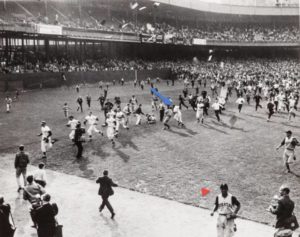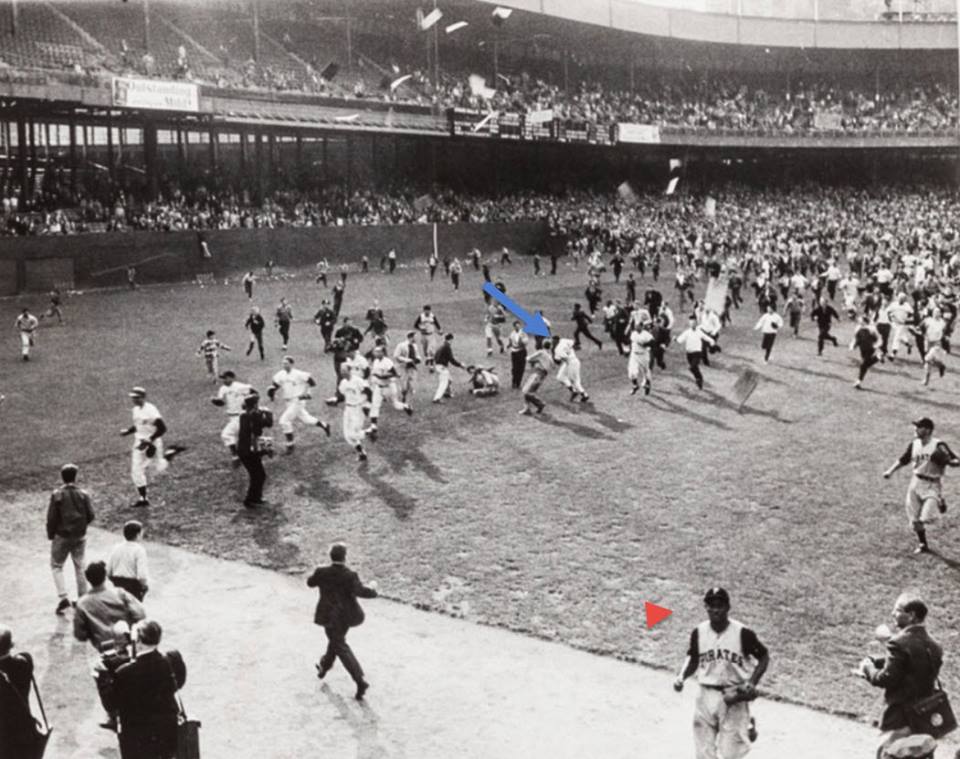“Giants Say Goodbye to the Historic Polo Grounds”
Click on any image below to start Photo Gallery:

The New York Giants Final Game in the Polo Grounds!
Thanks to my Old-Time baseball Photos partner Ron for calling my attention to the fact that on September 29, 1957, just four days after the Dodgers played their last game in Ebbets Field, the Giants played their last game in the Polo Grounds. Like the last game at Ebbets Field, this one was also against the Pirates, and resulted in a 9-0 Giant loss. Thus ended the National League presence in New York with the departure for the West Coast of two of its premier franchises, the Brooklyn Dodgers and the New York Giants..
When the final out was recorded that day at 4:35 PM, the curtain came down on the Giants’ historic 75 years in the National League while residing in New York. They were formed in 1883 after inheriting the players from the defunct Troy, New York National League team. The Polo Grounds, in its present location, had been their home since 1891. After one particularly satisfying victory over the Philadelphia Phillies in 1888, the year of their first National League championship, manager Jim Mutrie stormed into the dressing room and exclaimed, “My big fellows! My giants!” From then on, the club was known as the “Giants.”
The Giants’ lineup for the last game found Danny O’Connor leading off and playing second base, with Don Mueller in right, Willie Mays in center, Dusty Rhodes in left, Bobby Thomson at third, Whitey Lockman at first, Daryl Spencer at short, Wes Westrum catching, and Johnny Antonelli the starting and losing pitcher. Hank Sauer appeared as a pinch hitter, as did five Giant relievers. The Pirates lineup included the familiar names of Bill Mazeroski, Dick Groat, Frank Thomas, Roberto Clemente, and Bob Friend. The umpiring crew was carried over from the Dodger series at Ebbets: Vic Delamore at home, Augie Donatelli at first, Vinnie Smith at second, and Ed Sudol at third. Just 11,606 fans showed up for the farewell game which was played in 2:15. The Giants finished the season with four straight losses and in sixth place at 69-85; while the Pirates finished seventh at 62-92.
The Giants’ final three outs in the bottom of the ninth took only 12 pitches from Pirates’ starter Bob Friend. Don Mueller flied out to right on the second pitch; Willie Mays grounded out to shortstop Dick Groat on the fourth pitch. And then Dusty Rhodes took the count to 3-2 before also grounding out to Groat. Immediately after the final out was recorded, thousands of fans swarmed on to the field, stripping the park of anything that could be removed as a souvenir: home plate, the bases, the pitching rubber, patches of outfield grass, infield dirt, signs, telephones, seats, outfield padding, even the bronze plaque on the memorial to Eddie Grant, the Giant hero who was killed in World War IUnder a banner proclaiming, “Stay Team Stay,” a chant started up, demanding owner Horace Stoneham’s head in a noose. Sensing that the scene was not safe and could easily get out of hand, the players immediately fled for their lives to the safety of the club house in center field.
The Polo Grounds had a marvelous run that had produced 17 pennants and five World Series championships. The era of the Giants in New York, which had produced such stars as John McGraw, Christy Mathewson, Frankie Frisch, Bill Terry, Mel Ott, and Willie Mays, had now come to an end. The iconic stadium had been the scene of two of the most famous plays in all of baseball history: Bobby Thomson’s “Shot Heard ‘Round the World in 1951, and Willie Mays’ “The Catch” in the 1954 World Series. It also saw its share of tragedy, including the death of Ray Chapman after a beaning from Carl Mays.
On hand for the final game were two of the original Giants from the Glory Days of 1911-13: Rube Marquard and “Laughing Larry” Doyle. The guest of honor was Blanche McGraw, widow of legendary Giants’ manager John McGraw. It was arranged for Blanche to be the last fan to leave the stadium.
The Polo Grounds survived for a few years and eventually became the temporary home to the expansion New York Mets in 1962 until their move into Shea Stadium. When it was finally demolished in 1964, the same wrecking ball (painted as a baseball) was used that brought down Ebbets Field.
Maybe someone can explain to me how baseball could allow its two great franchises to leave New York. Of course money was involved, but I still don’t quite understand it…
-Gary Livacari
Photo Credits: Thanks to my Old-Time Baseball Photos partner Ron for sending the featured photo; all others found in public domain
Information: Excerpts edited from New York Times.com article: “On this Day”. Read more at: http://www.nytimes.com/learning/general/onthisday/big/0929.html
Subscribe to my blog for automatic updates and Free Bonus Reports: “Memorable World Series Moments” and “Gary’s Handy Dandy World Series Reference Guide.”

